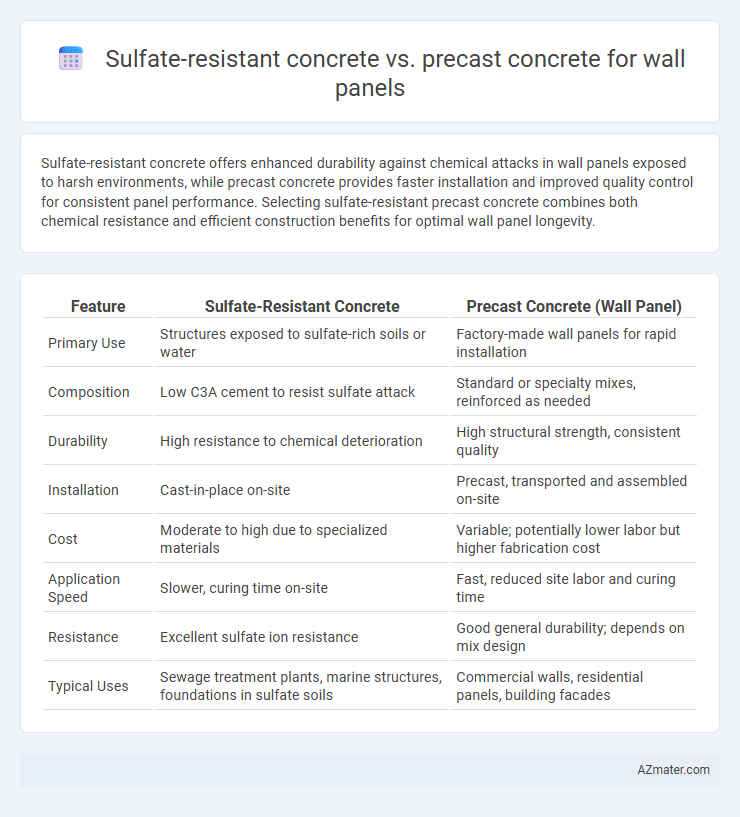Sulfate-resistant concrete offers enhanced durability against chemical attacks in wall panels exposed to harsh environments, while precast concrete provides faster installation and improved quality control for consistent panel performance. Selecting sulfate-resistant precast concrete combines both chemical resistance and efficient construction benefits for optimal wall panel longevity.
Table of Comparison
| Feature | Sulfate-Resistant Concrete | Precast Concrete (Wall Panel) |
|---|---|---|
| Primary Use | Structures exposed to sulfate-rich soils or water | Factory-made wall panels for rapid installation |
| Composition | Low C3A cement to resist sulfate attack | Standard or specialty mixes, reinforced as needed |
| Durability | High resistance to chemical deterioration | High structural strength, consistent quality |
| Installation | Cast-in-place on-site | Precast, transported and assembled on-site |
| Cost | Moderate to high due to specialized materials | Variable; potentially lower labor but higher fabrication cost |
| Application Speed | Slower, curing time on-site | Fast, reduced site labor and curing time |
| Resistance | Excellent sulfate ion resistance | Good general durability; depends on mix design |
| Typical Uses | Sewage treatment plants, marine structures, foundations in sulfate soils | Commercial walls, residential panels, building facades |
Introduction to Sulfate-Resistant Concrete and Precast Concrete
Sulfate-resistant concrete is specifically formulated to withstand sulfate-rich environments, utilizing low-C3A cement to prevent chemical attacks that cause deterioration. Precast concrete, produced in controlled factory settings, offers precise dimensional accuracy and improved quality, making it ideal for wall panels with complex shapes and quick installation. Comparing both, sulfate-resistant concrete ensures durability against aggressive soils and groundwater, while precast concrete emphasizes efficiency and versatility in construction.
Understanding Sulfate Attack in Wall Panels
Sulfate-resistant concrete is specifically formulated with low calcium content and supplementary cementitious materials like fly ash or slag to prevent sulfate attack, which causes expansion and deterioration in wall panels exposed to sulfate-rich environments. Precast concrete wall panels, while offering controlled quality and rapid installation, require sulfate-resistant mix designs in sulfate-exposed conditions to avoid chemical degradation from sulfate ions. Understanding sulfate attack involves recognizing the formation of expansive ettringite and gypsum, which lead to cracking and loss of structural integrity in non-resistant concrete panels over time.
Key Properties of Sulfate-Resistant Concrete
Sulfate-resistant concrete for wall panels is designed with low permeability and high durability to withstand sulfate attack in aggressive soil and groundwater environments, utilizing Type V cement or blended cement with supplementary cementitious materials like fly ash or slag. Its key properties include enhanced chemical resistance, reduced calcium hydroxide content, and improved long-term strength retention, preventing expansion and cracking caused by sulfate reactions. Precast concrete wall panels, while offering factory-controlled quality and faster installation, may require sulfate-resistant mixtures when used in corrosive sulfate-rich conditions to ensure structural longevity.
Overview of Precast Concrete Wall Panels
Precast concrete wall panels are factory-produced structural elements designed for rapid on-site installation, offering consistent quality and enhanced durability. These panels can be engineered with various additives, including sulfate-resistant cement, to withstand aggressive soil and groundwater conditions. Their modular nature supports efficient construction while maintaining structural integrity and resistance to environmental factors.
Durability Comparison: Sulfate-Resistant vs Precast Concrete
Sulfate-resistant concrete offers superior durability in environments with high sulfate concentrations by minimizing sulfate attack and reducing the risk of chemical degradation in wall panels. Precast concrete, while advantageous for controlled manufacturing conditions and consistent quality, may require additional protective measures when exposed to aggressive sulfate environments to prevent early deterioration. The selection between sulfate-resistant and precast concrete for wall panels should prioritize sulfate exposure levels, with sulfate-resistant concrete providing enhanced longevity where sulfate aggression is a critical concern.
Installation and Construction Methods
Sulfate-resistant concrete for wall panels is designed to withstand aggressive sulfate environments, requiring specialized mixing and curing processes to ensure durability and strength during installation. Precast concrete wall panels offer faster on-site installation due to factory-controlled conditions, enabling precise dimensions and reduced construction time with minimal curing delays. Both methods demand skilled labor for handling and placement, but precast panels simplify on-site logistics compared to the in-situ pouring needed for sulfate-resistant concrete.
Cost Analysis: Material and Labor Considerations
Sulfate-resistant concrete typically incurs higher material costs due to specialized cement and additives designed to withstand sulfate attack, impacting the overall budget for wall panels. Precast concrete offers cost advantages in labor by enabling controlled factory conditions and faster onsite assembly, reducing installation time and labor expenses. Evaluating cost-effectiveness requires weighing the premium for sulfate resistance against the labor savings and quality consistency of precast manufacturing.
Environmental Performance and Sustainability
Sulfate-resistant concrete exhibits enhanced durability in aggressive soil and groundwater conditions, reducing the need for frequent repairs and resource-intensive maintenance, thus improving environmental performance. Precast concrete wall panels offer benefits such as reduced construction waste and energy-efficient manufacturing processes due to controlled factory environments and bulk production techniques. Combining sulfate-resistant mixtures with precast technology maximizes sustainability by extending service life and minimizing carbon footprint associated with on-site construction activities.
Maintenance Requirements and Longevity
Sulfate-resistant concrete offers enhanced durability against chemical attacks from sulfate-rich environments, significantly reducing maintenance needs for wall panels in industrial or coastal settings. Precast concrete wall panels provide precise factory-controlled quality and faster installation but may require regular inspections to address potential joint deterioration and surface wear over time. Both materials ensure long-term performance; however, sulfate-resistant concrete extends service life in aggressive conditions, minimizing repair frequency compared to standard precast options.
Choosing the Best Wall Panel Solution: Factors to Consider
Sulfate-resistant concrete offers enhanced durability for wall panels exposed to aggressive sulfate-rich environments, making it ideal for industrial or coastal applications prone to chemical attack. Precast concrete wall panels provide precision manufacturing, faster installation, and consistent quality, suitable for projects emphasizing speed and aesthetic control. Key factors in choosing between these options include site exposure conditions, structural requirements, project timeline, and budget constraints.

Infographic: Sulfate-resistant concrete vs Precast concrete for Wall panel
 azmater.com
azmater.com